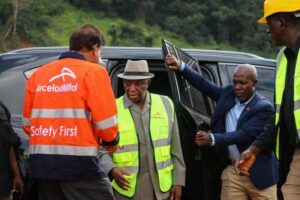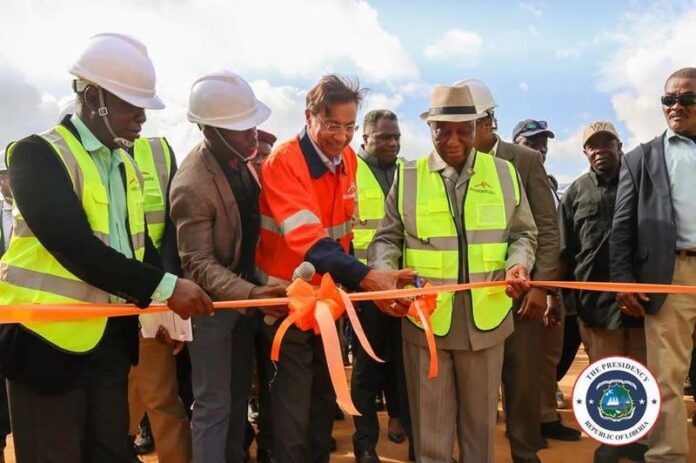ArcelorMittal Liberia has officially inaugurated a state-of-the-art iron ore concentrator at its Tokadeh mine in Nimba County, marking a major milestone in Liberia’s mining sector and broader post-war economic transformation.
The facility—now the largest iron ore concentrator in West Africa—is expected to quadruple Liberia’s iron ore output. It represents the centerpiece of ArcelorMittal’s Phase II Expansion Project, a $1.8 billion investment that brings the company’s total stake in Liberia to approximately $3.5 billion.
The inauguration ceremony, attended by Liberia’s President Joseph Nyuma Boakai and ArcelorMittal Executive Chairman Lakshmi N. Mittal, highlighted the project as one of the most significant private-sector investments in Liberia since the civil war. President Boakai hailed the development as a “turning point” in Liberia’s industrial future and a testament to the country’s stability and resilience.
The new concentrator is designed to transform Liberia’s abundant but lower-grade hematite ore (~35% Fe content) into premium 66% Fe magnetite concentrate using advanced beneficiation technology. The upgrade adds significant value before export, aligning with Africa’s broader push toward value addition and industrialization. “The iron ore that leaves Liberia should not just be raw material—we must add value, create jobs, and build an industrial base for our future,” President Boakai stated.
Echoing the African Union’s vision for mineral-led development, ArcelorMittal’s investment demonstrates how resource-rich African nations like Liberia, and by extension Ghana and others, can leverage natural wealth to drive homegrown industrial transformation. Lakshmi Mittal remarked that the concentrator “guarantees the long-term future of mining in Liberia,” solidifying the country’s role as a key supplier of high-grade iron ore.
In parallel with boosting output, ArcelorMittal’s expansion also emphasizes infrastructure development. The company has modernized the 243-kilometer railway linking Tokadeh to the port of Buchanan, laying hundreds of thousands of new sleepers, enhancing track geometry, and installing new passing loops to accommodate long, heavy trains. These upgrades elevate Liberia’s mining corridor to meet international standards and lay the foundation for regional integration.
Crucially, ArcelorMittal supports an open-access policy for the railway, collaborating with the Liberian government to develop a framework allowing other mining companies to utilize the infrastructure under fair agreements. This creates the potential for Liberia to serve as a regional mineral hub, with iron ore from neighboring Guinea and Sierra Leone possibly routed through Liberia’s enhanced logistics network in the future.
President Boakai emphasized the strategic importance of these projects, stating they are “essential to deepening Liberia’s integration into global value chains and unlocking long-term benefits for our people.”
The Phase II expansion has already delivered significant socioeconomic impact. During the construction phase, over 5,000 jobs were created—most of them filled by Liberians. Now operational, the concentrator is expected to support around 1,000 permanent roles in mining, rail, processing, and port operations. “This brings great relief to our economy noting that it is impacting the area of job creation,” said President Boakai.
ArcelorMittal Liberia currently employs about 2,000 Liberians full-time and has created more than 10,000 direct and indirect jobs during its two decades in the country. To ensure lasting benefits, the company has expanded its Training Academy in Yekepa, offering a fully funded, multi-year technical training program. Dozens of young Liberians are being trained in mechanical, electrical, and processing disciplines to run the new concentrator. “They are the true face of Liberia’s tomorrow,” President Boakai noted.
Local businesses have also benefitted, with Liberian contractors engaged in civil works, transportation, and support services—stimulating local economies across Nimba, Bong, and Grand Bassa counties.
With future expansion in mind, ArcelorMittal has built infrastructure capable of handling up to 30 million tonnes of iron ore annually, beyond the initial 20 Mt target. Officials have hinted at a phased ramp-up and plans for a pelletizing plant, potentially adding more in-country processing and helping West Africa gain a stronger foothold in the global steel supply chain.
On the community front, ArcelorMittal contributes around $3 million annually to a Community Development Fund, which has financed schools, clinics, water systems, and livelihoods in host communities. President Boakai underscored the importance of corporate responsibility: “Large investments must enrich the corporate social responsibility envelope… so that communities feel the benefits not just in employment, but in schools, clinics, and markets.”

The successful commissioning of the Tokadeh concentrator underscores what’s possible when stable policy, infrastructure investment, and community engagement align. “We would not have invested this scale of capital—nearly $3 billion—if we didn’t believe in Liberia and its people,” said Lakshmi Mittal, signaling ArcelorMittal’s long-term confidence in the nation.
Beyond Liberia, the project holds regional significance. Its alignment with continental initiatives such as the African Continental Free Trade Area (AfCFTA) showcases how integrated infrastructure corridors can drive industrialization and trade across borders. The emphasis on beneficiation and skills development reflects Agenda 2063’s goals of inclusive growth and sustainable development.
For other resource-rich African nations—including Guinea, Sierra Leone, and Ghana—Liberia’s model offers valuable lessons: local processing and infrastructure investment can multiply the economic impact of natural resources and position Africa not only as a source of raw materials, but as a leader in global value chains.
In conclusion, the newly inaugurated Tokadeh concentrator stands as a landmark of African industrial progress—symbolizing resilience, ambition, and meaningful partnership. As Liberia prepares to export its first high-grade iron ore from the facility later this year, a powerful message resonates across the continent: Africa is open for business—and ready to transform its natural wealth into lasting prosperity.


